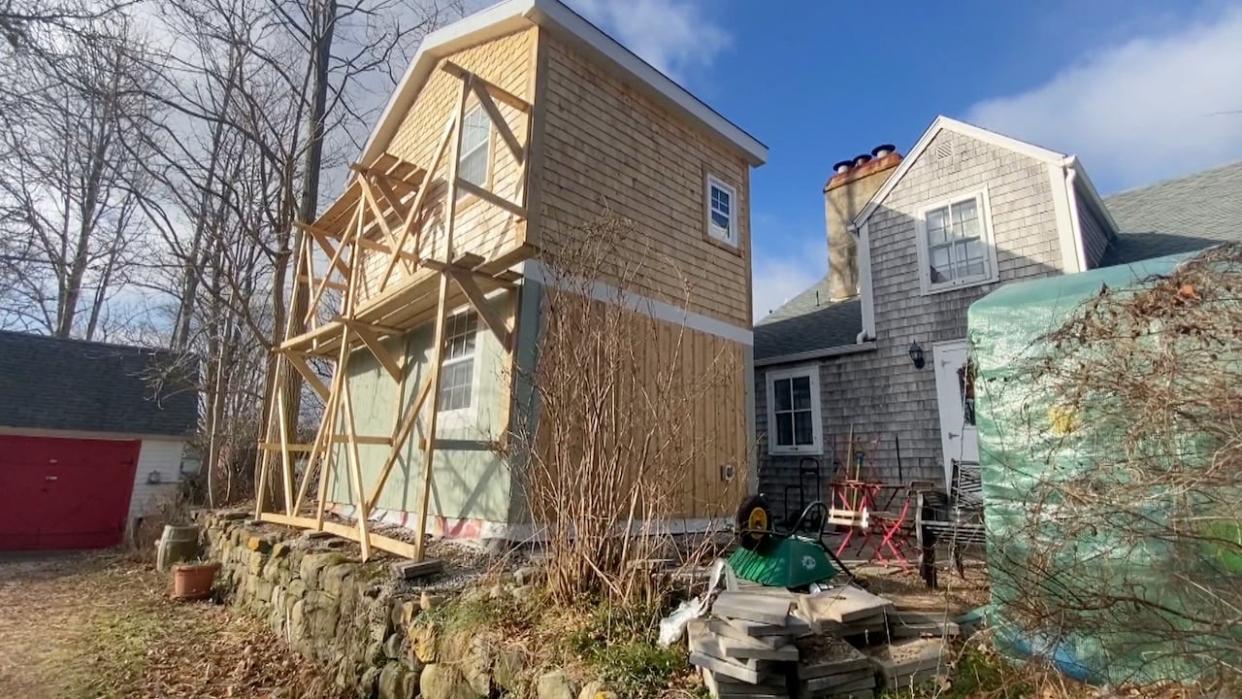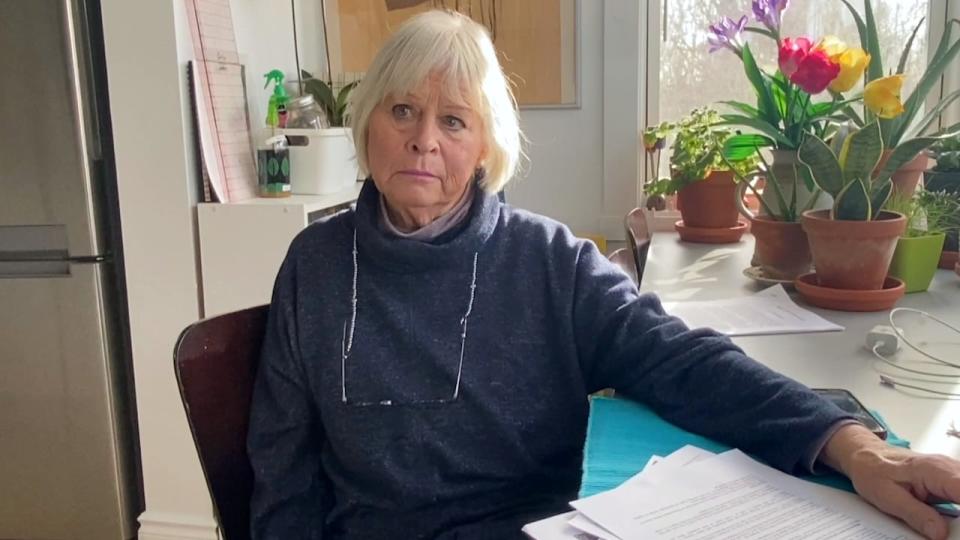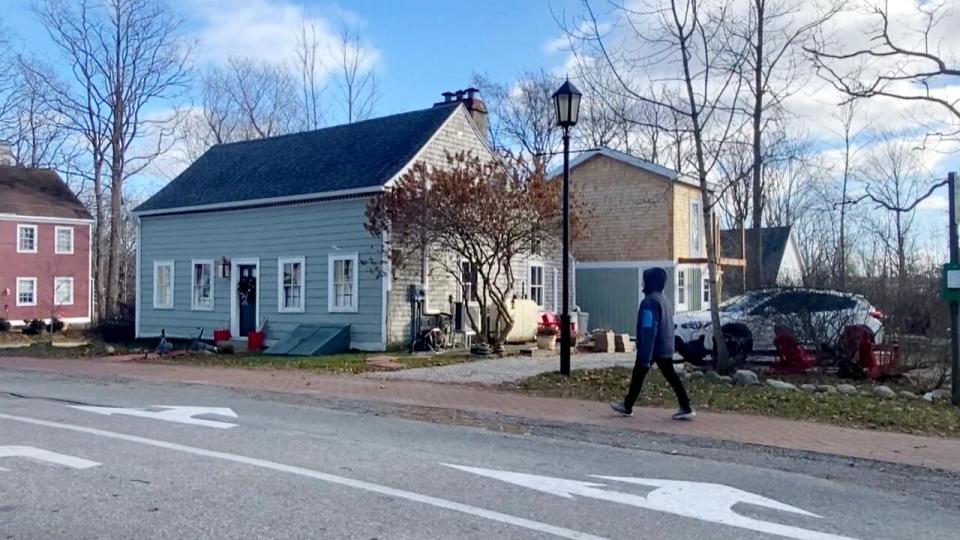This N.S. town allowed neighbours to appeal a building's height — but it was already up

A new two-storey cabin on a Shelburne heritage property has angered many residents, who say the town used a faulty process and broke municipal and provincial rules to allow it.
The Shakespear House at 17 George St., in the town's historical waterfront zone, was built in 1784 by Stephen Shakespear and sits on a corner with similar homes. The intersection is described as the only one in North America that features four Georgian-era wood-framed buildings that are still in use, and is a popular spot for tourists.
This summer, a 12–foot-high shed at the rear of the property was replaced with a 21-foot-high wooden building with sewer, electricity and a balcony. The owner has said it will be used for family visits, short-term rentals and storage.
"It's sacrilege, basically," said neighbour Willa Magee.

Willa Magee lives at 109 Water St., the property adjacent to the Shakespear House. (CBC)
Magee is among a group of Shelburne residents who say the new building breaks the town's land-use bylaw in multiple ways, including rules for the historical zone and a 15-foot maximum height for accessory buildings.
The new cabin is also very close to the property line along Magee's backyard, and sits atop an old stone wall. Magee said she's worried about the building toppling over into her yard during a storm.
Magee and other residents complained to the town this summer when they saw the old shed had been removed, and the new building appeared to be going higher than they expected. They eventually requested a stop-work order, but that did not happen.
The Shelburne Historical Society presented arguments to town council on Sept. 5, saying that the form and style of the new building didn't match the Shakespear House beside it or others in the area.

Chris Sharpe is president of the Shelburne Historical Society. (CBC)
"All of the criteria that are supposed to be followed have been ignored," said Chris Sharpe, the society's president, in an interview.
Sharpe told town council in September that if a variance had been granted to allow construction beyond the 15-foot maximum height, the neighbours hadn't been given the chance to appeal as required under the Municipal Government Act.
Town building inspector Andrew Goreham, who also acts as development officer, told council at the September meeting he didn't think a variance was needed. Goreham said the height was "close" to 15 feet but he was unsure of the exact number, adding that other accessory buildings in town are above that height.
However, weeks later on Oct. 12, Goreham sent letters to the property owners within 30 metres of the site. The notice said the town had granted the property owner a variance to build to a height of 21 feet, and neighbours had two weeks to appeal.

A letter from the Town of Shelburne to residents on Oct.12 notifying them of the 21-foot height variance granted to the owner of the Shakespear House property. (Willa Magee)
Don Leggett, who lives in a nearby Georgian home on Water Street, questioned why the letters were even sent .
"What was the intention?" he asked. "It's done."
He said it seems inaccurate to call the new structure an accessory building, such as a garage or shed, because it is fully-serviced and will be a residential building.
Another neighbour, Steve Hirchak, agreed — calling it "the only shed in Shelburne with a balcony" in his appeal letter.
Leggett also said he faced a similar situation years ago when he wanted to raise the height of his own shed.
"I was told, 'no, you can't do that. It doesn't fit in with the community … doesn't fit the bylaws,'" Leggett said. "All of a sudden it seemed like that all went out the window. The rules didn't apply anymore."

Don Leggett lives in a Georgian-era home on Water Street, across the road from Shakespear House. (CBC)
Sandra Bell, the owner of Shakespear House, said during a Sept. 18 council meeting that she applied and received the proper building and development permits in April. Bell said Goreham approved widening the structure, and increasing the height to 17 feet.
Although she had hoped to save some of the original shed, Bell said her contractor told her the wood was too old to be safe. At that point, she asked Goreham if she could extend past 17 feet if they were no longer working with pre-existing walls, she said.
Bell said Goreham told her there was no restriction on how many floors an accessory building could have or how tall it could be.
Owner followed advice 'at every step'
"I asked for, and followed, the town's and municipality's advice at every step," Bell said. "I did everything possible I knew to ensure I was in compliance."
During an emotional presentation, Bell said she moved to Shelburne from Ontario in 2021 with hopes of fitting into the community, and caring for the municipally and provincially registered Shakespear House.

The Shakespear House was built in 1784 and sits on the corner of George and Water streets. The 21-foot high 'accessory building' is visible at the rear of the property. (CBC)
But she said residents and the historical society had painted her with a construction "scarlet letter." Shelburne was a filming location for the 1995 movie of the same name.
"Being forced to defend myself, despite having done nothing wrong, is alarming," Bell said.
Although four neighbours appealed the variance, council dismissed the appeals during a meeting on Nov. 6.
Coun. Elizabeth Acker said it was a "very unfortunate situation."
Town sought legal advice
Mayor Harold Locke and Chief Administrative Officer Sarah Mattatall declined interview requests.
But in an email, Mattatall said the town "sought legal advice on this issue and carefully followed the guidance provided by our legal counsel."
A spokesperson for Nova Scotia's Department of Communities, Culture, Tourism and Heritage also said by email that Shakespear House is a provincial heritage property based only on the unique heritage value of its main log building.
"While the log building is protected under the Heritage Property Act, the former shed found on the property did not contribute to the property's provincial heritage value," Susan Mader-Zinck said. "As a result, approval for its demolition was not required by the Province under the Heritage Property Act."
Sharpe said he believes fault ultimately lies with the town for its "gross violation" of the Municipal Government Act, and that the situation has created a dangerous precedent in which others could follow suit and disregard bylaws.
Although Sharpe is a member of Shelburne's heritage advisory committee, which was reinstated in the wake of the situation, he said he has little faith it will help prevent similar problems in future. These committees, which are found in many Nova Scotia municipalities, provide advice to local councillors but there's no obligation for them to follow it.
"It would appear to be the Wild West," Sharpe said, "that anybody can do whatever they like with the Georgian houses, and the town will come along and clean up afterward with a retrospective zoning variance."
MORE TOP STORIES

 Yahoo News
Yahoo News 
